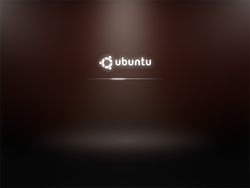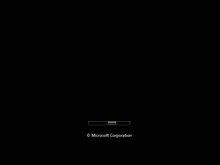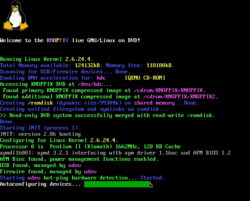
A bootsplash, also known as a bootscreen, is a graphical representation of the boot process of the operating system.
A bootsplash can be a simple visualization of the scrolling boot messages in the console, but it can also present graphics or some combinations of both.
Unlike splash screens, a bootsplash is not necessarily designed for marketing purposes; it can be intended to enhance the experience of the user as eye candy, or provide the user with messages (with an added advantage of color-coding facility) to diagnose the state of the system.
Microsoft Windows
All versions of Microsoft Windows feature a boot screen, which is loaded during the startup process. With extra, third-party utilities, it is possible to replace the default Windows boot screen with custom images, text, and/or animations.
Windows Vista

In Windows Vista, the default boot screen is represented by a green indeterminate progress indicator. The boot screen can be changed so that it displays a static image of an aurora with the text, "Starting Windows Vista" by enabling the "No GUI boot" option within the Windows System Configuration Utility (msconfig.exe). Microsoft would update the aurora image throughout the lifecycle of the operating system, starting with the first service pack, where it was altered to match the image displayed during the operating system's hibernation screen.
Windows 7

In Windows 7, the boot screen will initially display the "Starting Windows" text, then a Windows flag animation will appear at the center of the screen. On unsupported systems, and sometimes when booting into recovery environment, the Windows Vista boot screen will be used instead as the fallback.
Changes of the boot screen, although possible through third-party utilities, is extremely risky and may cause the system to be unable to boot. Also, the hidden "Aurora" boot screen was removed.
Windows 8 and later

In Windows 8 and later, the boot screen will display the Windows logo along with the loading circle. On Legacy boot, the boot screen is displayed in 1024×768 resolution, and the boot screen is squished to accommodate for the 16:9 aspect ratio. On UEFI boot, the boot screen is displayed in highest resolution available. If the ACPI BGRT table is present, the boot screen will display the OEM logo instead.
Linux distributions

- Bootsplash – the first and original implementation of a Linux kernel bootsplash, superseded by Splashy
- fbsplash – Gentoo implementation as bootsplash program
- Plymouth – uses Direct Rendering Manager (DRM) and KMS driver
- Splashy – a graphical boot process designed to replace the aging Bootsplash program
- usplash – former bootsplash program used by Ubuntu
- XSplash – new splash program used by Ubuntu starting from 9.10
- bootanimation - a simple splash for Android OS just showing some decompressed images.
See also
- Splash screen – an image that appears while a computer program is loading
References
- ^ Shawn Brink (1 May 2007). "How to Enable the Hidden Aurora Boot Screen in Vista". Retrieved 30 November 2014.
- barrygolden. "Boot screen components - Windows drivers". docs.microsoft.com. Retrieved 2 January 2021.
- "Welcome to the graphical world of Linux". BootSplash.org. Core Systems. 26 July 2007. Archived from the original on 5 September 2008. Retrieved 30 May 2011.
- "Fbsplash Homepage". Retrieved 7 November 2016.
Further reading
- Tyler, Chris (30 May 2007). "Wednesday Why: rhgb - Graphical Boot Screen". Fedora Daily Package. Archived from the original on 10 July 2011. Retrieved 30 May 2011. - RHGB: The bootsplash program used by Red Hat distributions
- Splashy
- "USplash". Ubuntu Documentation. Ubuntu Foundation. 27 November 2009. Archived from the original on 23 May 2011. Retrieved 30 May 2011.
- "Better Startup Experience (Graphical Boot Sequence)". Fedora Project Wiki. Red Hat, Inc. 16 June 2009. Retrieved 30 May 2011.
- "Change XP Boot Screen". Jake Ludington's Digital Lifestyle. Ludington Media West, LLC. Archived from the original on 13 June 2011. Retrieved 30 May 2011.
- "How to Enable the Hidden Aurora Boot Screen in Vista". vistax64.com. Designer Media Ltd. 1 May 2007. Retrieved 30 May 2011.
- James, Scott (2 September 2009). "Making a splash". Scott James Remnant. Archived from the original on 8 October 2009. Retrieved 30 May 2011.